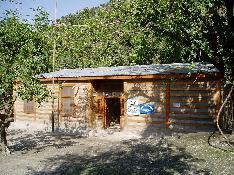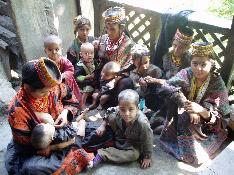20050901
The Kalash
 The Kalash are a tribal people who live in three valleys of the Hindu Kush mountain range in Pakistan's Northwest.
The Kalash are a tribal people who live in three valleys of the Hindu Kush mountain range in Pakistan's Northwest.Their ancestry is enveloped in mystery and is the subject of controversy. Some historians believe the Kalash are descendants of the soldiers of Alexander the Great. Others say the Kalash ancestors migrated to Afghanistan from a distant place in South Asia and that they are indigenous who came from what is now the Nuristan area. However, it has been established that the Kalash migrated to Chitral, Pakistan's Northwest Frontier Province, from Afghanistan in the 2nd century B.C. by the 10th century A.D.
The Kalash are a friendly and cheerful bunch, who love music and dancing, particularly on their religious festivals. With original customs, clothes, religion and beliefs, this people are unique in the Muslim universe around Pakistan and have tried to keep their traditions and heritage alive througout the times.
The thriving Kalash culture began to fall in 1320 A.D. when villages were subjected to mass Islamic conversion. Its population decreased from 10.000 in 1951 to 3.700 in 1998 and nowdays the Kalash are one of the world's endangered minority communities.
20050801
Culture
 The Kalash religion is based on myths and superstitions that relate to the relationship between the human soul and the universe. This relationship, according to Kalash mythology, should be manifested through music and dance, which also contributes to the pleasure of gods and goddesses. In their festivals music and dance are performed not as an entertainment item, but as a religious ritual.
The Kalash religion is based on myths and superstitions that relate to the relationship between the human soul and the universe. This relationship, according to Kalash mythology, should be manifested through music and dance, which also contributes to the pleasure of gods and goddesses. In their festivals music and dance are performed not as an entertainment item, but as a religious ritual.One of the most important features of this people include the womens' traditional female dress which includes a black robe, an embroidered long cap decorated with cowrie shells, ornaments and beads. This style of dress is still popular among local women despite the availability of a variety of modern clothes.
The Kalash celebrate four major festivals commemorating seasonal change and significant events in agro-pastoral life. These festivals are Joshi or Chilimjusht, Uchal, Phoo and Chowmos. During the festivals they sacrifice animals at altars to please gods and goddesses. This religious ritual is performed with high regard for the supernatural beings, according to the Kalash mythology.
The Kalash language is called Kalasha which is an archaic type of Indo- European language (Dardic subgroup). It has a rich tradition of folklore, epics, love songs and idioms demonstrating a high standard of indigenous wisdom and human experience. This knowledge is believed to be on the verge of extinction. The new generation of Kalash does not know much about their non-material culture and heritage.
20050701
Resistence though Education
 In the Birir Valley - one of the most picturesque valleys where a number of converted Kalashs are concentrated - a tiny group of Kalash decided to estabilish an autonomous and independent Kalash Community School. The school strives to preserve the written language and the endangered traditions and heritage of its culture and prevent these valuable traditions from dying out.
In the Birir Valley - one of the most picturesque valleys where a number of converted Kalashs are concentrated - a tiny group of Kalash decided to estabilish an autonomous and independent Kalash Community School. The school strives to preserve the written language and the endangered traditions and heritage of its culture and prevent these valuable traditions from dying out.With only two volunteering teachers, both Kalash, the school is maintained by the contribution of the Kalash community itself. But this effort is not enough alone to support the demands of the 44 children aged from 5 to 12 and around 30 adult women who benefit from the project.
The school does not have any facilities and all the students need support to obtain scholar material, adequate books and other necessities.
20050601
How to help the Community School
 The Kasash Community School in Birir are immensely grateful for any donation which you are able to give. This may be through the sponsorship of a Kalash student and/or help towards the development of the school, allowing the continuity of this important project for the conservation of the culture and heritage of the Kalash people.
The Kasash Community School in Birir are immensely grateful for any donation which you are able to give. This may be through the sponsorship of a Kalash student and/or help towards the development of the school, allowing the continuity of this important project for the conservation of the culture and heritage of the Kalash people.Please, choose one or both of the options below and send an e-mail to: turabkalash@hotmail.com entitled "I want to sponsor a CBS Birir".
1. Children and Woman's Sponsor - US$ 150,00 student/year. You will be helping to provide the payment of the teachers, as well as books and school material demanded during the year.
2. School Infraestructure's Sponsor - US$ 100,00 quota/year. You will be helping to provide facilities such as water, electricity, materials and other benefits to the structure of the school.
The donation can be actioned through bank deposit to:
Community Based School - CBS Birir
Habib Bank - Chitral/Pakistan
Count n. N03628-0
20050501
This website
 This website was created voluntarily by a foreigner who visited the Birir valley and the community school with the aim to help their activities. The project is managed by the Kalash community itself. For any doubts or enquiries, please send an e-mail to: yseabra@yahoo.com.br
This website was created voluntarily by a foreigner who visited the Birir valley and the community school with the aim to help their activities. The project is managed by the Kalash community itself. For any doubts or enquiries, please send an e-mail to: yseabra@yahoo.com.br